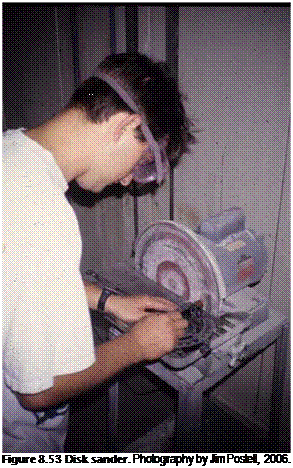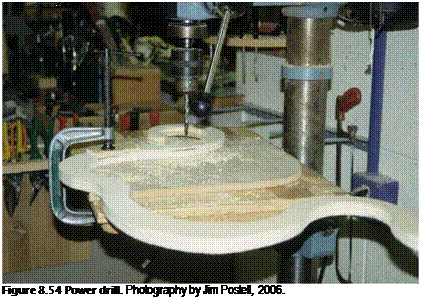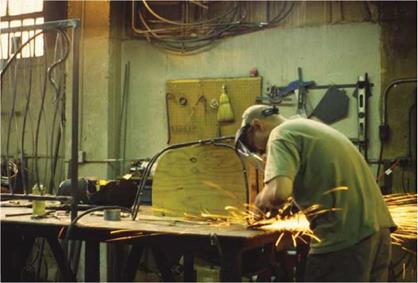Woodshops utilize a variety of power tools, which include table saws, jointers, planers, power sanders, and power drills (Figures 8.52 and 8.53). With the advent of power drills and drill presses, the traditional brace and bit all but disappeared. Electric power drills are powerful and easy to use. One should also investigate the battery-operated hand tools that are available.
When drilling through wood, the outgoing bore tends to create an outward explosion in the surface of the wood. This occurs in both flat and rounded surfaces, including large dowels. A tight, uniform backing applied to the wood being drilled will prevent this from
|
Figure 8.52 Woodshop with power tools, Miami University, Oxford, Ohio. Photography courtesy of Gulen Qevik. |
 happening. Drilling through dowels requires a jig in which the dowel should fit firmly. Prior to drilling dowel holes, consider using Forstner bits because they will ensure a quality result. Forstner bits are high-quality drill bits with a special serrated ring around the main point. This ring helps the bit stay on course and creates a clean, precise hole.
happening. Drilling through dowels requires a jig in which the dowel should fit firmly. Prior to drilling dowel holes, consider using Forstner bits because they will ensure a quality result. Forstner bits are high-quality drill bits with a special serrated ring around the main point. This ring helps the bit stay on course and creates a clean, precise hole.
Power drill presses (pillar drills) have a chuck that holds the required bit (Figure 8.54). The shank (thickness of the bit) generally ranges in size from Vn to У2 inch (0.8 mm to 1.27 cm), and drill types range from wood and metal multiuse drill bits to Forstner bits.
High-speed steel bits are used to cut wood or metal. Large drill bits are often made with a reduced shank so that they can fit into standard power drill chucks. Spade bits have long points for positioning on the exact center of a marked hole. These bits are also known as paddle bits due to their profile. Most power drill presses have an adjustable table, a feed lever, and, most significantly, a depth gauge that can be set to determine accurately the depth of a hole.
The power planer and power jointer are important power tools in any woodshop. Planers mill wood to a specific thickness. Planing lumber is limited to the width of the planer. Power jointers are important in creating 90-degree corners in milling lumber. Generally, lumber is first jointed, then planed. Once a 90-degree edge is made between two adjoining surfaces on a jointer, the lumber can be milled to its desired finished thickness.
 |
In cutting metal, be certain to use a slower cutting speed for harder metals and keep a small amount of oil on the cutting surface at all times. Metal band saws are typically speed-adjustable, cutting faster for softer metals such as copper and
|
Figure 8.55 Student grinding a metal weld. Photography by Jim Postell, 2006. |
slower for harder metals such as carbon steel. Kerf marks and burrs left in the metal should be removed immediately with a file after each cut. Be especially careful of the burrs created when drilling metal and when grinding and welding metal (Figure 8.55).
When cutting plastic, use a blade specifically for this material. Push slowly and deliberately throughout each cut. Leave the protective adhesive sheet on the stock until all cuts are complete to minimize the risk of scratching the plastic. Take extra care when drilling acrylic. Drill slowly to avoid cracking the plastic and distorting the hole.
Metal and plastic can be folded. Sheet metal up to 12-gauge can be folded back onto itself. Care must be taken to ensure that the line of the fold is accurate and continuously aligned. Sheet plastic such as acrylic can be folded by first heating along the edge of the fold and then carefully making the fold and securing it in place until the plastic cools.




